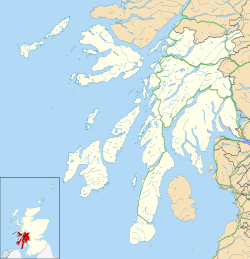Kilchurn Castle
| Kilchurn Castle | |
|---|---|
| Argyll and Bute in Scotland | |

Kilchurn Castle
|
|
|
Location in Argyll and Bute
|
|
| Coordinates | 56°24′13″N 5°1′44″W / 56.40361°N 5.02889°WCoordinates: 56°24′13″N 5°1′44″W / 56.40361°N 5.02889°W |
| Type | Castle |
| Site information | |
| Owner | Historic Environment Scotland |
| Open to the public |
Yes |
| Condition | Ruined |
| Website | Historic Scotland |
| Site history | |
| Built | 15th century |
| Built by | Clan Campbell |
| In use | 15th century-1760 |
| Fate | Renovated frequently, destroyed by lightning |
Kilchurn Castle is a ruined structure on a rocky peninsula at the northeastern end of Loch Awe, in Argyll and Bute, Scotland. It was first constructed in the mid-15th century as the base of the Campbells of Glenorchy, who extended both the castle and their territory in the area over the next 150 years. After the Campbells became Earls of Breadalbane and moved to Taymouth Castle, Kilchurn fell out of use and was in ruins by 1770. It is now in the care of Historic Environment Scotland and is open to the public in summer.
The Campbells of Glenorchy were the most powerful cadet branch of the Clan Campbell, and over two centuries from the 1430s came to dominate the central Highlands. The building of several castles, of which Kilchurn was the first, was a key part of their territorial expansion duing this period. Sir Colin Campbell, 1st of Glenorchy (died 1475), was a younger son of Duncan Campbell, 1st Lord Campbell, ancestor of the Earls of Argyll. Sir Colin was granted Glen Orchy and other lands by his father in 1432, and afterwards established Kilchurn around 1450. The first castle comprised the five-storey tower house, with a courtyard defended by an outer wall. At the time Kilchurn was on a small island scarcely larger than the castle itself, and would have been accessed via an underwater or low-lying causeway.
Sir Colin's son, Sir Duncan Campbell of Glenorchy, built the 'laich hall' - a single-storey dining hall built along the inside of the south curtain. Sir Duncan was one of the many Scottish nobles killed at the Battle of Flodden in 1513. During the second half of the 16th century, another Sir Colin Campbell, the 6th Laird (1499–1583), further improved the castle's accommodation by adding some chambers to the north of the tower house, and remodelling the parapet. This included the introduction of the circular corner turrets adorned by corbels. Sir Colin also constructed Balloch Castle (now Taymouth Castle) by Loch Tay, to consolidate the Campbell's territorial gains in Perthshire, which had been achieved largely at the expense of their former allies, the Clan MacGregor of Glenstrae.
...
Wikipedia

